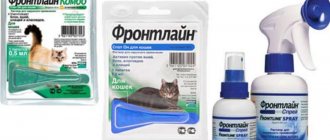Among all cat problems, a contagious disease that is caused by a group of scabies mites stands out. Parasites penetrate the skin, causing a lot of anxiety to the animal. Unpleasant symptoms accompanied by itching are only the visible part of the iceberg. Scabies in cats can have serious consequences. To eliminate the disease, it is necessary to diagnose the type of pathogen in time and treat the pet with prescribed medications.
Signs of the disease
global $ads_google; //data-ad-slot=”2475549904″ $ads_google = empty($ads_google) ? false : true; ?> if ($ads_google == false) {?>
$ads_google = true; ?> } ?>
Scabies in cats manifests itself with a whole range of symptoms. They begin to appear as the tick spreads across the animal's skin. As a rule, infection begins from the cat's head. Signs become apparent 5-7 days after infection. Thickened formations covered with crusts appear at the site of parasite penetration. Such plaques can be seen on the center line of the nose, at the base of the ears, along the eyebrows.
Further, the symptoms expand. The changes concern mainly the skin, but since they affect the pet’s well-being, behavior changes. The animal becomes irritable and even aggressive. The cat may refuse food, sleep poorly, and not participate in games. Common signs of scabies are:
- frequent scratching of the body and head;
- deterioration in wool quality and hair loss;
- formation of bald spots on the body;
- swelling of the lymph nodes;
- the appearance of white pustules;
- redness and suppuration of scratches;
- covering of the opened papules with scales.
The appearance of even one of the signs of scabies in a cat is a reason to consult a veterinarian.
Diagnosis of pathologies in animals
The primary signs of scabies are similar to the symptoms of allergies, fungus, dermatitis, lichen, etc. Self-treatment cannot be prescribed; an incorrectly chosen method can lead to serious consequences. When making a diagnosis, the veterinarian relies not only on external signs. An examination is required; a scraping is taken from the affected area of the body to detect and determine the type of parasite. Laboratory examination of the obtained material will help prescribe effective treatment.
Types and causes of the disease
Not all cats are susceptible to infection. This may be due to direct and indirect reasons. They relate to the physiological state of the animal, its care and a number of other circumstances. The development of scabies in cats is promoted by:
- decreased immunity;
- unsanitary conditions;
- lack of insecticidal treatment;
- kitten age up to two years;
- genetic predisposition.
Scabies mites are microscopic organisms; their sizes are measured in fractions of a millimeter. The shape, body length, and structural features depend on the biological species. This determines the type of disease. Various mites cause demodicosis, otodectosis, notoedrosis, and sarcoptic mange. In each case, its own specific symptoms are observed and adequate drug treatment is prescribed.
Demodicosis
The causative agent is the light gray Demodex canis mite. The parasite settles in hair follicles and sebaceous glands. Infection sometimes occurs in the newborn period. Affected areas may be small - up to 2.5 cm (localized form) or spread over most of the body (generalized form). The first one often goes away on its own.
Demodicosis manifests itself in the form of scaly redness or in the form of ulcers and ulcers. The generalized form of the disease often combines both symptoms. In this case, it is very difficult to treat the cat, as complications often arise.
global $ads_google; //data-ad-slot=”2475549904″ $ads_google = empty($ads_google) ? false : true; ?> if ($ads_google == false) {?>
$ads_google = true; ?> } ?>
Otodectosis
The ear mite Otodectes cynotis parasitizes the external and internal parts of the auricle. This type of disease is accompanied by the formation of scabs and scales on the surface of the auditory organ.
A strong putrid odor emanates from the affected area. Ear mange causes your cat to constantly scratch his head and especially his ears.
Notoedrosis
The disease, often called scabies, is caused by the Notoedres scabies mite. It has a round shape and gray color. This type of disease in cats affects the outer side of the ear. A gray liquid with an unpleasant odor accumulates in the affected areas.
Due to the discharge, the fur sticks together, later it begins to fall out and the pet’s head goes bald. In exposed areas, scales accumulate, forming scabs.
Sarcoptic mange
The causative agent of the disease is the yellowish or completely white mite Sarcoptes scabiei. The parasites first settle on the cat's face and then spread to the entire body. The diagnostic sign is the formation of red spots with thin gray lines with a nodule at the end. An inexperienced person may confuse sarcoptic mange with an allergy, since their symptoms are similar in appearance
Sarcoptic mange is dangerous due to bacterial infection and general sepsis.
Causes of mange in cats
The cause of the disease is the active activity of the Notoedres cati tick. These parasites can cause the most severe infectious skin diseases. They live in the lower layers of the dermis, feeding on skin particles and lymph. This is where they lay their eggs. In one day, 1 female tick is capable of laying from 2 to 8 eggs, and in her entire life - about 20 eggs.
Ticks have a spherical shape, the color of the body is gray. The length of the parasite is about 0.14-0.45 mm. It has small suction cups on its paws, which it uses to cling to the animal.
Scabies mites in cats may not always cause the development of the disease. The most susceptible to this are:
- emaciated animals;
- cats with reduced immunity;
- young animals;
- have not undergone special antiparasitic treatment.
Most often, scabies is only a secondary disease. Therefore, its appearance may indicate the presence of more severe disorders in the cat’s body.
Is scabies contagious to humans?
The question of whether scabies is transmitted to humans or not worries every owner of a fluffy cat. The disease is considered contagious and can spread to other animals and humans. These parasites cannot live outside a living organism; they definitely need a host. However, scabies mites, having penetrated the epidermis of human skin, cannot exist in it for a long time. Symptoms of infection with sarcoptic mange or notoedrosis look like an allergy. In rare cases, otodectosis can cause otitis externa.
global $ads_google; //data-ad-slot=”2475549904″ $ads_google = empty($ads_google) ? false : true; ?> if ($ads_google == false) {?>
$ads_google = true; ?> } ?>
Human skin is too dense for scabies mites; they cannot lay eggs in it or move around. This feature saves a person from cat scabies. In the short period while the ectoparasite is in the upper layers of the dermis, it causes itching and discomfort. After spontaneous healing, the symptoms disappear. Despite these features, when treating a sick cat, the owner must observe personal hygiene measures:
- use gloves when handling your pet;
- wash your hands with soap after treatment procedures;
- boil things that the cat has come into contact with;
- Regularly vacuum carpets and wash floors in the house.
Scabies mites disappear from the human body in less than a month.
Methods of infection
The main route of infection is contact. Outside the host, the tick can live for a very short time; all processes of feeding, growth and reproduction take place only in the skin of the animal. However, notoedres cati is highly contagious between cats. If someone in a group of animals develops this disease, it is highly likely that all of them will soon become infected. In the environment, a tick can live up to a week and still remain infectious. That is, even cats that live only in an apartment without access to the street have a small chance of becoming infected with a tick that the owners brought from a walk on clothes or shoes.
Since the body’s own immunity also plays a role in the development of clinical symptoms, it is quite rare to see notoedrosis in street cats. However, such cats can be hidden carriers, meaning that they themselves do not get sick, but can infect others - for example, your pet cats.
Diagnosis of scabies
If you suspect your cat has scabies, it is important to seek veterinary help promptly. The clinic will help make an accurate diagnosis and prescribe adequate treatment. Diagnostics includes an external examination of the animal and taking skin scrapings for microscopic analysis. This procedure is repeated two or three times to confirm the output. Based on the results, the doctor makes a conclusion about the cause of the problem. Often, a mite infestation can be confused with dermatitis, an allergic reaction, ringworm, or eczema. Therefore, a laboratory test is mandatory in the diagnostic system.
The duration of therapy is determined by the severity of the disease and the condition of the pet itself. The average treatment period for scabies ranges from one to four weeks. Medical care for a pet consists of injections, ointments, solutions, drops, and hygiene products with a therapeutic effect (shampoos, soaps). To eliminate scabies in cats, acaricides, antibiotics, antihistamines, antiseptics, and immunomodulators are used. To prevent the cat from licking the ointment applied to the surface of the skin, it is necessary to use a protective cap.
Risk factors
The stronger the cat’s immunity, the greater the likelihood that he will cope with the parasite on his own, because not all animals that come into contact with scabies mites get sick. There are several factors that can increase your risk of infection. These include:
- damage to the skin (wounds, scratches, ulcers);
- close contact with sick cats, cats and other animals;
- weakened immunity due to recent surgery, treatment with antibiotics or hormonal drugs;
- the presence of helminths or external parasites (fleas, ticks, lice);
- unbalanced, insufficient calorie diet;
- age younger than two years or older than eight.
It should be noted that British and Siamese cats and male cats are slightly more likely to develop mange than other breeds. This is explained by the individual characteristics of their body.
Treatment of demodicosis
To help an adult cat or kitten, complex therapy is needed, including several drugs with different effects. You can treat your pet at home, but a treatment plan is developed by a veterinarian. If the disease is mild, then bathing with tar soap is sufficient to treat the animal. After this, sulfur ointment is applied to the affected areas or wiped with an infusion of medicinal herbs with anti-inflammatory and antiseptic effects (chamomile, calendula, string).
For a localized form, liquid medicine Tsipam, Ivermek, Amide, Ectodes, Perol is used. The product is applied to the lesion 1-2 times a week. These drugs are not used during pregnancy. When treating a generalized form of scabies, the cat's hair is first shaved off. Then the skin is treated with acaricidal preparations. At the same time, subcutaneous injections of Cydectin and antibiotics (Betamox, Amoxicillin or Camacidin) are given. Drops against fleas and ticks are applied to the withers (for example, Amit Forte).
Treatment of scabies in cats
Treatment of scabies should begin with isolating the animal. This will help prevent family members and other animals from becoming infected. After this, use the medicine prescribed by your doctor. It can be in the form of injections, drops or ointment.
Additionally, the owner can alleviate the animal’s condition by washing away dead epidermis, fallen hair, and crusts of dried blood. This should be done as carefully as possible and in protective clothing.
How is otodectosis treated?
For ear scabies, the pet is prescribed medications with amitraz (Amitrazin, Tsipam), hexachlorane (Aurikan), as well as acaricides and insecticides (Neostomozan, Surolan, Ectodes, Aurikan, Dana). First, the surface of the auricle is cleaned with a cotton pad soaked in antiseptic. Then the liquid medicine is instilled. After this, the base of the ear is gently massaged so that the medicine is evenly distributed over the surface. For hygienic sanitation before treatment, you can use lotions and solutions:
- Otifri
- Otoklin
- Fitolar
- Furacilin
- Hydrogen peroxide
- Potassium permangantsovka
- Chlorhexidine
When treating scabies in cats, the medicine is instilled into both ears, regardless of the lesion.
Prevention
The best preventive measure is the regular use of antiparasitic drugs, in cats this is usually drops on the withers. If you pick up a stray cat on the street, you need to show it to a doctor before bringing it home. If there are already cats at home, it is recommended to isolate them from the new resident for a period of quarantine, observation and, if necessary, treatment. Typically, domestic cats are left in their usual quarters, and the new pet is given a separate small room.
Treatment of notohedrosis
Before using medications, it is necessary to remove hair from the outer part of the ears in the affected area. The second step is to bathe the cat with shampoo that contains acaricidal components. In the early stages, you can treat your pet with local remedies. Aversectin or novertine ointment is suitable for this; they are applied twice a week. An alternative may be Demos gel, the frequency of its use is once every four days.
global $ads_google; //data-ad-slot=”2475549904″ $ads_google = empty($ads_google) ? false : true; ?> if ($ads_google == false) {?>
$ads_google = true; ?> } ?>
For systemic treatment of feline scabies, injections of drugs based on ivermectin (1%) are prescribed - five injections every five days. The therapy includes Stronghold drops with selamectin or Advocate, they are used every three weeks.
Symptoms
With any disease, a living organism develops certain symptoms that can tell which direction to look. The symptoms are given so that the pet owner can quickly react and seek help from a veterinary center as quickly as possible! When scabies appears, the following symptoms are observed:
- In areas where the disease is active, hair loss may occur. Such places most often are the areas of the muzzle and limbs;
- If the disease is not cured in time, small bald “islands” can be replaced by entire “continents of no fur”;
- When insects enter the flesh under the skin, this causes the formation of peculiar lumps. Such formations can reach 10 mm in diameter;
- the skin itself, in the place where the insect landed, can become inflamed and crusty;
- when palpating the bumps, when there is a hole in them, a very thick, but almost transparent consistency may flow out;
- when the microflora of wool follicles is disrupted, folliculitis is observed;
- general weakness of the body;
- apathy;
- sometimes, loss of appetite.
Many people believe that the name of the disease, scabies, is directly related to the word itch. Therefore, there is an omission in observing the pet’s symptoms. Be aware that a cat with scabies may not itch more often than usual. If the symptoms listed above appear, and in addition to all this, your pet often itches, this may indicate the presence of another or related disease. In any case, you need to consult a doctor.
When seeking help from a specialist, as a rule, a diagnosis of the disease is carried out, where all the symptoms are compared and a certain examination is prescribed.
How is sarcoptic mange treated?
This type of disease requires treatment of the cat's entire body, so treatment at home is a labor-intensive but necessary process. As in other cases, it is necessary to remove hair so that ointments and solutions are more effectively distributed over the skin. Next, the cat is washed with tar soap or shampoo (Nizoral, TM Doctor).
For injections, acaricidal agents Ivermectin, Doramectin, Aversect are prescribed. For the treatment of sarcoptic mange, Sayfli tablets and local ointments Aversectin, Novertin, and Sulfur are intended. Preparations in solutions are also suitable for external use: Stomazan, Amit Forte, Amitrazine Plus. A choice of drops of coffee is dropped onto the withers of a sick cat: Lawyer, Stronghold, Fighter, Frontline.
Most anti-scab drugs are strong poisons that place increased stress on the liver. To support it, the cat needs hepatoprotectors.
How to get rid of scabies mites?
The first stage of treatment is removing parasites from the pet’s skin. Veterinarians can prescribe various topical medications. A simple sulfur ointment has a good disinfecting effect. The use of Stomazan and Butox solutions is also allowed. When carrying out treatment, it is important to fully follow the specialist’s recommendations. A missed day can lead to a deterioration in the pet's general condition. The number of parasites will increase, intensifying the itchy scabies.
The disease in cats is treated with several antiparasitic drugs: • “Baymek” • “Amirtrazine” • “Novomek”
To treat sarcoptic mange and otodectosis, a veterinarian may prescribe Stronghold drops, an antiparasitic medicine for external use. Ivermectin has a strong effect in treatment. It contains gamma-aminobutyric acid, which causes paralysis in parasites. Veterinarians do not recommend using it to treat small kittens.
The second stage is strengthening the pet’s immune system; a course of vitamins is prescribed. When the body is strong enough, the healing process will noticeably accelerate. With weak immunity, the disease can manifest itself again.
What are the possible consequences of scabies?
Areas affected by subcutaneous mites cause unbearable irritation in the cat. She combs the areas that bother her. Wounds and scratches are open gates for viral, bacterial and fungal infections. Pathogenic microorganisms cause inflammation. In severe situations, the outbreak festeres. In the absence of timely treatment of scabies and secondary infection, the cat may develop general sepsis.
Ticks, which lead an active lifestyle in the layers of the skin, secrete toxins. Toxic substances enter the blood and cause disturbances in the functioning of the central nervous system, heart, and lungs. With cat scabies, oxygen starvation is possible at the cellular level, which occurs due to metabolic disorders under the influence of harmful compounds.
The dangers of ignoring the disease
Without treatment, your cat will not get rid of mange. The disease can only be aggravated by the addition of a bacterial infection. Microorganisms enter through skin damaged by scratching, causing pustules and large wounds.
A mite that has settled in the ear can cause inflammation of the eardrum, middle and inner ear. As a result, the cat faces deafness, and in the most severe cases, death.
Preventive measures
To prevent infection with skin mites, it is necessary to remember and apply the rules of prevention. Firstly, if possible, it is advisable to protect your pet from contact with street animals. They often suffer from this contagious disease. Secondly, during routine insecticidal treatment it is periodically necessary to use selamectin-based products. It is enough to use such drugs once every six months. Thirdly, for hygiene procedures it is useful to use shampoos with insecticidal additives (for example, with tar).
At home, it is important to regularly carry out wet cleaning. A balanced cat diet also provides additional support. When you have enough minerals and vitamins in your diet, it is easier to keep your immune system healthy. It is also important to protect your pet from stress and hypothermia. A healthy, well-groomed cat is much less likely to be affected by subcutaneous mites and does not even pose a temporary threat to humans.
global $ads_google; //data-ad-slot=”2475549904″ $ads_google = empty($ads_google) ? false : true; ?> if ($ads_google == false) {?> $ads_google = true; ?> } ?>
Treatment at home
The first thing to do is isolate the sick pet to prevent the disease from spreading and infecting other pets. The choice of medications depends on the shape and type of scabies mite and the degree of infection.
Typically, cats are prescribed a comprehensive treatment aimed at eliminating parasites, as well as restoring their general condition.
Complex treatment may include the following:
- antiparasitic drugs;
- injections of the ivermectin series (Novomec, Ivemex, Ivermectin);
- external insecticidal agents and solutions: Stomazan, Butox, Neostomazan, Mitroshin solution, etc.;
- symptomatic remedies;
- antiparasitic, anti-inflammatory ointments, for example, Amitrazine;
- emulsions, gels, special shampoos;
- immunostrengthening drugs (Immunoparasitan);
- immunomodulators;
- mineral and vitamin supplements.
Description of the disease
Scabies in animals occurs due to infection by skin mites. In veterinary medicine, this disease is diagnosed as acarosis. This name is general and includes several forms of pathology caused by different types of skin mites.
Cat scabies can be localized or generalized . In the first case, ticks infect only certain parts of the animal's body. But the parasites do not spread to the limbs. In the second case, the disease can affect all parts of the body and paws. Generalized scabies is more difficult to treat.











